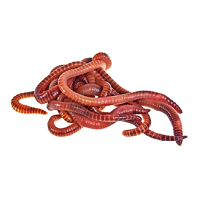Everything You Need to Understand About Red Wigglers for Composting
Red wigglers, or Eisenia fetida, play a pivotal duty in the world of composting, changing organic waste into valuable dirt modifications. The procedure of setting up a worm container and preserving it can present challenges.
What Are Red Wigglers?

(Lake Hickory Worms,)
Belonging To The United States and copyright, red wigglers are surface-dwelling microorganisms that favor moist, warm habitats rich in breaking down raw material. Their diet plan is composed largely of decomposing plant product, food scraps, and various other organic debris, which they consume and break down efficiently. As they digest this product, they create nutrient-rich castings that enhance soil fertility.
Red wigglers are hermaphroditic, having both male and female reproductive body organs, and can duplicate swiftly under optimal problems. This ability makes them a perfect choice for composting systems, as their populace can boost rapidly. Their strength and versatility to various settings even more solidify their relevance in lasting waste administration methods. Overall, red wigglers are essential contributors to the procedure of recycling organic waste right into important garden compost.
Benefits of Making Use Of Red Wigglers
Utilizing red wigglers in composting systems provides many benefits that enhance both the effectiveness of waste monitoring and the quality of the resulting compost. These worms, clinically referred to as Eisenia fetida, are particularly effective at breaking down natural issue, transforming kitchen scraps and lawn waste right into nutrient-rich garden compost at an increased price.
One of the primary benefits of utilizing red wigglers is their capability to eat huge amounts of natural material, typically refining their weight in food waste daily. This high intake price brings about faster decomposition and reduces the volume of waste sent to garbage dumps. The spreadings created by red wigglers are rich in vital nutrients, helpful bacteria, and enzymes, making them an excellent plant food for yards and plants.
In addition, red wigglers grow in a range of atmospheres, making them adaptable for both indoor and outdoor composting systems - red wigglers. Their presence in a garden compost container assists to aerate the material, preventing smells and advertising a healthy composting process. Overall, employing red wigglers not just adds to efficient waste management but additionally sustains sustainable gardening practices via the manufacturing of premium compost
(red wiggler worms for sale)
Establishing Your Worm Bin
To effectively establish a worm bin, it is vital to pick an appropriate container that satisfies the requirements of red wigglers while giving a helpful environment for composting. An appropriate bin can be made from plastic, timber, or steel, with a capacity of at the very least 1 square foot for every single extra pound of worms.
Make sure the container has ample drainage holes to stop excess wetness, as red wigglers grow in a wet, but not waterlogged, atmosphere. red wigglers. The bin Check This Out must additionally be ventilated to supply adequate air movement, preventing anaerobic conditions that could hurt the worms
A suitable area for the worm container is an awesome, dark area, without straight sunshine and severe temperatures, as red wigglers choose a temperature series of 55 to 77 degrees Fahrenheit.
Prior to presenting the worms, prepare bed linen materials such as shredded paper, cardboard, or coconut coir, which will certainly give both environment and food. Moisten the bed linen lightly to create an inviting setting for the worms. Last but not least, take into consideration positioning a lid on the bin to keep moisture and minimize insects, while ensuring it can be conveniently gotten rid of for maintenance.
Feeding and Care Standards
Feeding red wigglers is a critical element of maintaining a healthy and balanced composting system. These worms flourish on a diverse diet plan, mainly made up of natural materials such as fruit and veggie scraps, coffee grounds, and smashed eggshells. It is vital to avoid feeding them meat, dairy products, and oily foods, as these can create undesirable odors and bring in insects.
When introducing food to your worm container, chop or shred materials right into smaller pieces to assist in quicker decay. Start with percentages to evaluate the worms' intake rate, slowly enhancing the amount as they adapt. It is advisable to alternating feeding locations within the bin to urge complete mixing and oygenation of the garden compost.

Troubleshooting Common Issues
Keeping a growing worm composting system can sometimes offer obstacles that call for focus and troubleshooting. Common issues consist of an undesirable smell, which usually indicates overfeeding or the presence of anaerobic problems. To treat this, lower the quantity of food included and make sure appropriate aeration by blending the bed linen material.
An additional regular problem is the escape of worms from the container. This can happen due to too much wetness or unsuitable ecological conditions. On a regular basis inspect the dampness degrees, going for a moist but not soaked consistency, and keep ideal temperature levels in between 60-80 ° F(15-27 ° C )to create a comfy habitat for your red wigglers.
Parasites, such as fruit flies, can likewise invade worm bins. red wigglers. To combat this, cover food scraps with a layer of bed linen or shredded paper to deter flies from laying eggs. In addition, guarantee that any type of food added is fresh and devoid of mold and mildew, which can attract undesirable pests
Finally, if your worms seem inactive, look for tension variables such as temperature variations or inadequate wetness. Addressing these typical concerns will assist keep a healthy and efficient worm composting system.
Conclusion
In summary, red wigglers, or Eisenia fetida, play an essential role in lasting waste monitoring through vermicomposting. Their capability to successfully convert organic waste right into nutrient-dense spreadings enhances soil health and wellness and advertises plant growth. Appropriate arrangement and upkeep of a worm bin, together with adherence to feeding standards, make certain a flourishing environment that minimizes landfill contributions. Resolving common problems without delay further supports the efficiency of this eco-friendly technique, contributing to environmental sustainability and agricultural efficiency.